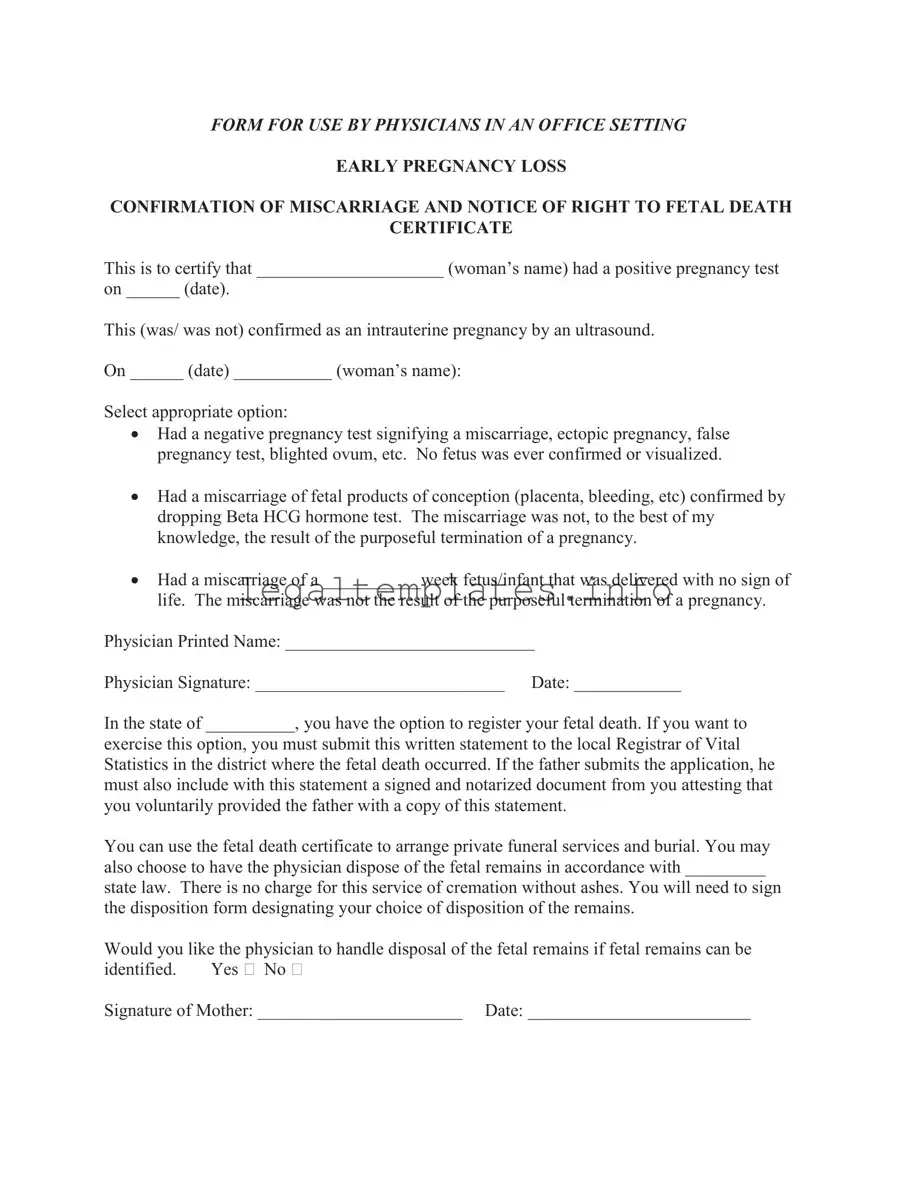The Birth Certificate Application form, like the Miscarriage Discharge Paper form, is used to officially record a significant life event. Whereas the miscarriage form documents the loss of a pregnancy, the birth certificate application captures the details of a birth. Both forms require personal information about the parent(s) and the event, and both serve as foundational documents for legal identification purposes. They are instrumental in establishing rights and accessing services, although they record events at opposite ends of the spectrum of life.
The Death Certificate Request form parallels the Miscarriage Discharge Paper by documenting the end of life. The miscarriage discharge paper provides an option to obtain a fetal death certificate, similar to how a death certificate signifies an individual's passing. Both documents require medical certification and are essential for legal and personal closure processes. They enable families to finalize affairs, access benefits, and, in the case of the fetal death certificate, arrange for burial or cremation services.
The Hospital Discharge Summary shares similarities with the Miscarriage Discharge Paper in its role as a medical document that summarizes a patient's care episode. While the discharge summary details treatment, diagnoses, and follow-up care after a hospital stay, the miscarriage form records the occurrence of a miscarriage and subsequent medical advice. Both documents are pivotal in ensuring continuity of care, informing future medical decisions, and providing a written record for both medical and administrative uses.
A Medical Records Release form, like the Miscarriage Discharge Paper, involves the handling of sensitive personal health information. The Miscarriage Discharge form contains detailed health information regarding the miscarriage and may need to be shared with other healthcare providers or entities, necessitating a release form. Both forms emphasize the importance of confidentiality and the patient's control over who can access their health information, reflecting the need to safeguard patient privacy.
The Prescription form, though primarily used for ordering medication, shares the feature of being a healthcare provider-initiated document with the Miscarriage Discharge Paper. Similar to how the discharge paper indicates a need for further care or instructions following a miscarriage, a prescription outlines the treatment plan through medication. Both are critical tools in the patient care continuum, ensuring that individuals receive recommended follow-up care, whether through medication or other means advised post-miscarriage.
An Advance Directive form, while broader in scope, shares a crucial aspect with the Miscarriage Discharge Paper: the anticipation of future medical decisions. The miscarriage form includes decisions regarding the disposal of fetal remains, similar to how an advance directive may include preferences about end-of-life care. Both documents are proactive in nature, allowing individuals to express their wishes regarding their care or the handling of sensitive situations, ensuring those wishes are respected.
The Consent for Medical Treatment form is inherently connected to the Miscarriage Discharge Paper through the theme of patient consent. In the aftermath of a miscarriage, certain medical or surgical interventions may be necessary, requiring explicit consent, much like any other medical treatment. Both documents underscore the importance of informed consent in healthcare, ensuring patients understand and agree to the proposed care plans or procedures.
The Surgical Operation Report, akin to the Miscarriage Discharge Paper, documents specific medical events and outcomes. After a miscarriage, if surgical intervention like a dilation and curettage (D&C) is required, an operation report would detail the procedure much as the discharge paper summarizes the miscarriage event. Both are critical for documenting healthcare encounters, guiding follow-up care, and contributing to the patient's medical history.
The Patients' Rights and Responsibilities form shares its foundation of patient advocacy with the Miscarriage Discharge Paper. The miscarriage form informs the patient of their right to obtain a fetal death certificate and decide on the disposition of fetal remains, reflecting a commitment to respecting patient choices and providing transparency. Similarly, a Patients' Rights form outlines a patient's entitlements and obligations within healthcare settings, emphasizing dignity, respect, and informed decision-making.
Last, the Patient History form and the Miscarriage Discharge Paper are alike in their collection of vital health information. The Miscarriage Discharge form details a specific, significant health event and its medical handling, contributing to a person's overall health history. In contrast, a Patient History form compiles broad health information to inform present and future care. Both are indispensable to achieving a comprehensive understanding of an individual's health background and ensuring tailored healthcare services.
